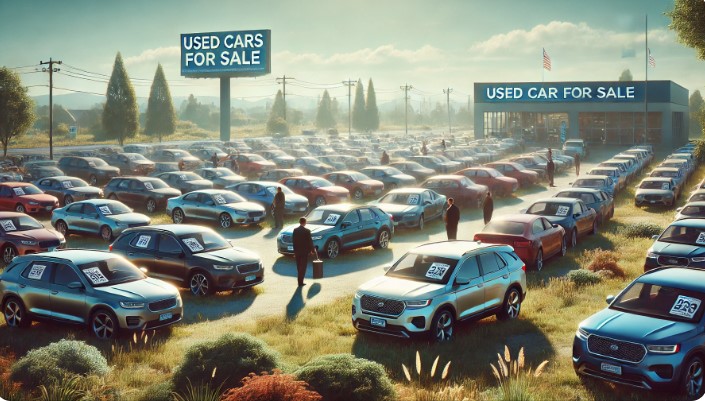During the pandemic, the used car market experienced an unprecedented surge, surprising both consumers and industry insiders alike. By mid-2021, used car prices had skyrocketed by over 50%, leaving car buyers scrambling and dealerships enjoying short-term profits. Fast forward to 2024, and the market has shifted dramatically, with prices now on the decline. What caused this drastic rise and fall in used car prices? What economic, supply chain, and consumer trends have shaped this market, and what does the future hold?
The Pandemic-Driven Surge in Used Car Prices
When the COVID-19 pandemic hit, it disrupted nearly every industry, but the automotive sector faced unique challenges. A series of unprecedented factors combined to drive demand for used cars sky-high, pushing prices to record levels.
Demand Surge: As COVID-19 spread in 2020, many people shunned public transportation due to health concerns, opting instead for personal vehicles. This spike in demand affected both new and used car markets, but supply couldn’t keep pace. New car production slowed due to factory shutdowns and supply chain issues, especially the global semiconductor shortage, which made new cars scarce and pushed more buyers toward the used car market.
Supply Chain Disruptions: Semiconductor chips, essential to modern vehicles, were in short supply as production lines worldwide struggled. Automakers drastically reduced new car output as they couldn’t get the chips needed. As new car inventory dwindled, demand for used vehicles surged, causing prices to rise by 32% to 36% in 2021. Wholesale prices saw an even greater increase, with some estimates showing a 52% jump.
Older Vehicles Appreciating in Value: With new cars increasingly out of reach for many, buyers turned to older used vehicles. Cars that were four to seven years old saw the highest price increases, as consumers sought out sub-$20,000 options—further pushing up prices.
The Factors Behind the Decline
By 2022, the market began to cool as the forces that drove prices up started to unwind.
Supply Chain Recovery and New Car Production Rebound: As supply chain disruptions eased and the chip shortage improved, automakers ramped up production. This increased availability of new cars reduced the pressure on the used car market. As more new cars became available, buyers began shifting back to new vehicles, lowering demand for used cars.
Rising Interest Rates and Inflation: In 2023, as the U.S. faced rising inflation, the Federal Reserve raised interest rates. This made car loans more expensive, with the average interest rate for used cars exceeding 14%. Higher borrowing costs deterred many potential buyers, reducing demand for used vehicles.
Market Rebalancing: By mid-2022, the market began to correct itself. Pandemic-driven demand for used cars cooled as public health concerns eased and work-from-home models became more common, reducing the necessity for personal vehicles. Rising gas prices and higher interest rates further discouraged car purchases, leading to a drop in demand.
Impact on Prices and Consumer Behavior
By 2023, used car prices had fallen by around 10%, with older models seeing the steepest declines—particularly those with lower fuel efficiency or outdated technology. Cars aged four to seven years experienced price drops of nearly 19%. This price reduction has impacted both dealerships and consumers.
Dealership Adjustments: Dealers, who had benefited from skyrocketing prices, have had to adapt to this new reality. With used cars no longer appreciating at pandemic rates, many dealers are more cautious about overstocking their inventory. To attract buyers, dealerships are offering better financing deals, trade-in bonuses, and other incentives.
Shifts Toward Affordable and Green Vehicles: As fuel costs rise and environmental concerns grow, consumers are increasingly opting for hybrids and electric vehicles, further depressing demand for older, gas-powered used cars. This shift is expected to continue putting downward pressure on the prices of these vehicles.
What Lies Ahead for the Used Car Market?
Looking forward, several factors will influence the future trajectory of used car prices.
Price Stabilization and Potential Rebound: Economic recovery will play a key role in stabilizing the market. If inflation moderates and interest rates fall, consumer confidence could return, prompting more buyers into the market. However, experts predict that while prices may stabilize, they are unlikely to return to the highs seen during the pandemic.
Technological Advancements and Vehicle Durability: As vehicles become more durable and fuel-efficient, the used car market could shift toward higher-quality, newer vehicles. This would likely lead to stronger demand for modern, fuel-efficient cars, while older gas-powered models may continue to lose value.
Long-Term Equilibrium: The used car market is expected to find a new balance as the supply of new vehicles normalizes and consumer preferences evolve. Dealers and consumers alike will need to adapt to this new reality, where used car prices remain more stable but are no longer experiencing the rapid appreciation seen during the pandemic.
Conclusion
The used car market has experienced a wild ride over the past few years, driven by pandemic disruptions, supply chain issues, and shifting consumer behavior. As prices have now dropped significantly from their pandemic highs, the future remains uncertain. Economic recovery, interest rates, and changing consumer preferences will all play a role in determining what happens next.
For consumers, this may be an opportune time to explore the used car market—but with caution, as prices continue to adjust in a post-pandemic world.
